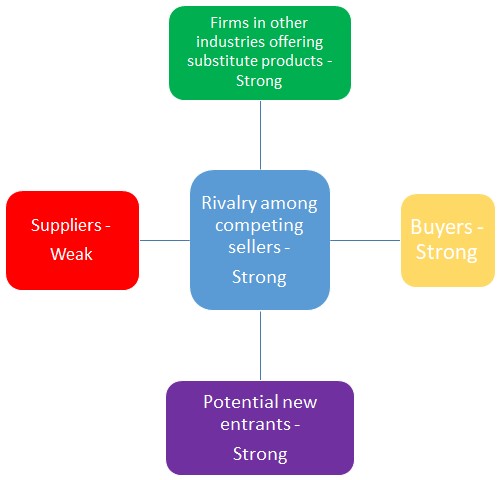PESTEL Analysis
Some of the factors influencing Costco Wholesale are general, while others can be specific. The political aspect is not different from other international entities, although the limited number of countries prevents more issues (Thompson, 2021). Simultaneously, if Costco Wholesale can exist in global markets without difficulties, it will signify potential expansions. The company is dependent on such economic conditions as low land costs and the number of businesses, determining the viability of establishing new warehouses, although the initiative may lead to missing opportunities. Consumer confidence was initially facilitated by the company, which bore its fruits in the absence of necessity to promote, saving costs (Thompson, 2021). Sociocultural trends, such as organic food consumption and movements for environmental protection, impact the range and the quality of products (Thompson, 2021). Adhering to them is beneficial for the company for customer retention and publicity. Thus, based on the first three factors, the strategy may include global expansion, more lenient conditions for warehouse establishment, considering that Costco Wholesale can afford most spots, and respect for sociocultural trends.
The last three factors are no less important for selecting the right strategy. Technological ones positively impact the company’s growth, expanding the stock and allowing it to sell more via websites (Thompson, 2021). Therefore, properly supervising e-commerce platforms and adding new gadgets to the inventory are essential directions. Environmental factors, such as global warming and endangered species, compel the company to use other electricity sources and ensure that the products do not include rare animals (Thompson, 2021). The restrictive self-imposed policies may be beneficial, as customers will appreciate the company for its efforts. Lastly, it follows numerous regulations, including Foreign Corrupt Practices Act and wage and hour hours, increasing the norm mentioned in the latter, which makes Costco Wholesale popular among the existing and potential employees. Overall, the best strategy would be to continue the current course and emphasize the successful policies.
Five Forces Analysis

Most of Costco Wholesale’s five forces are strong, except for suppliers. They are easily interchangeable, allowing the company to continue its operation undisturbed, and the strategy in this direction should be reinforced. The power of buyers is strong, considering the membership aspect and their financial background, and changing anything may affect the company. Firms from other industries that share their products with Costco Wholesale are numerous, so it is important to maintain the appeal through low prices and other unique offers. Two main rivals exist, both with strengths that deserve to be studied and weaknesses, which can be used to the company’s advantage. Although it may seem that new entrants cannot threaten Costco Wholesale’s positions, it is still underrepresented in some countries, where local initiatives can easily become more successful, so strengthening global markets is paramount. Thus, the strategy for suppliers and buyers may remain the same, while other fields need attention.
Identifying the Driving Forces of Industry Change
- Increasing globalization.
- Improving Internet capabilities.
- Technological change.
- Environmental concerns.
- Policy changes.
- Product innovation.
- Societal concerns and lifestyles.
According to the previous points, several driving forces can be distinguished. For instance, the need to expand the international market indicates the increasing globalization, which makes it more desirable to reach new countries. The improving Internet capabilities simplify the selling process, contribute to expansion, and eliminate the need to establish new warehouses. Technological change impacts both the selection range and the means of production, opening the possibility for sustainability. Environmental concerns also have implications, from energy concerns to the merchandise variety. Consequently, some policies may explicitly state whether certain practices are forbidden considering the situation, forcing the company to comply. Product innovation expands the stock and makes the available items more ecologically friendly, which is a selling point for a group of customers. Lastly, societal norms and lifestyles influence what appropriate or worthy of censure, so it is important to navigate the complicated field and accept the new norms. A socially, ecologically, and culturally conscious company has more chances to survive and prosper in a complex world.
Competitor Analysis
Compared to its competitors, Costco Wholesale has more visible strengths, although its weaknesses are also considerable. While the companies are similar in some aspects, such as objectives and pricing policies, they possess different resources and implement those strategies that benefit them. What Costco Wholesale should do to separate itself from the rivals further is to strengthen its international positions, maintain stability, continue to adapt to new trends, and diversify its products to minimize substitutions.
Key Success Factors & Industry Outlook for Profitability
- Pricing and quality.
- Sustainability.
- Employee satisfaction.
- Low-cost locations.
- Robust membership.
Costco Wholesale owns its success to the combination of pricing and quality, employee satisfaction, customer loyalty, and viable strategic decisions, such as sustainability and low-cost locations. Facilitating them in the future is an essential component of preserving the company’s success and reputation. Its profitability largely depends on how well it will adhere to the changing trends and regional sensibilities, considering that innovations may initially lead to losses. As the industry leader, Costco Wholesale influenced the model of its competitors, so it should lead them to a more sustainable but attractive future.
Reference
Thompson, A. A. Jr. (2021). Case 3: Costco Wholesale in 2020: Mission, business model, and strategy. In A. Thompson et al. (Eds.), Crafting & executing strategy: The quest for competitive advantage: Concepts and cases (23rd ed., pp. C18-C42). McGraw-Hill Education.